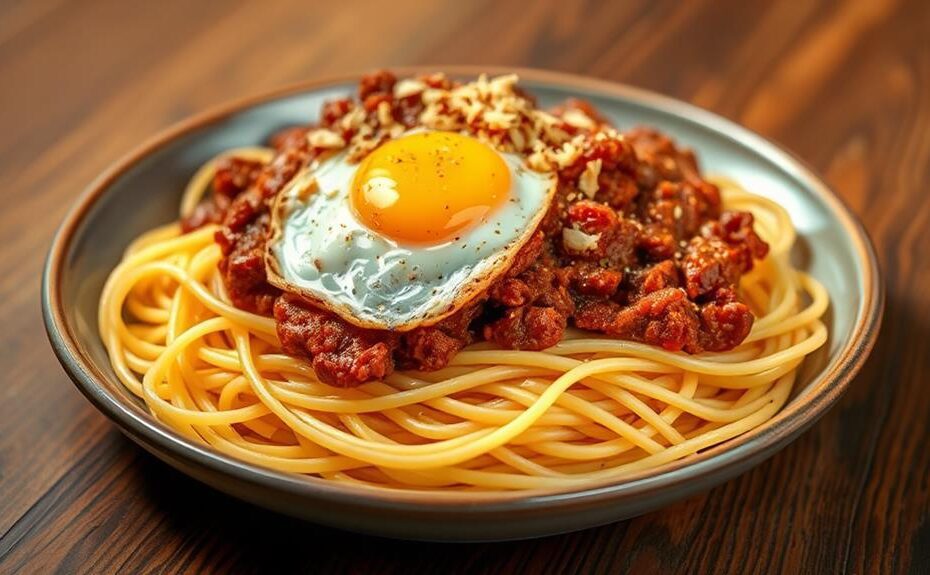Simmering the Sauce is Key
To perfect Spaghetti Pinoy Style, you need to simmer the signature sweet sauce for at least 30 minutes to meld the flavors together.
Adding Protein for Depth
Include sliced hotdogs and ground pork to add a savory depth to the dish.
These ingredients will enhance the flavor profile of the spaghetti.
Balancing Flavors
Achieve balance by adding a sprinkle of brown sugar to cut the acidity, a dash of Knorr Pork Cube for umami, and a generous helping of banana ketchup for that unmistakable Pinoy flavor.
Filipino Spaghetti 101
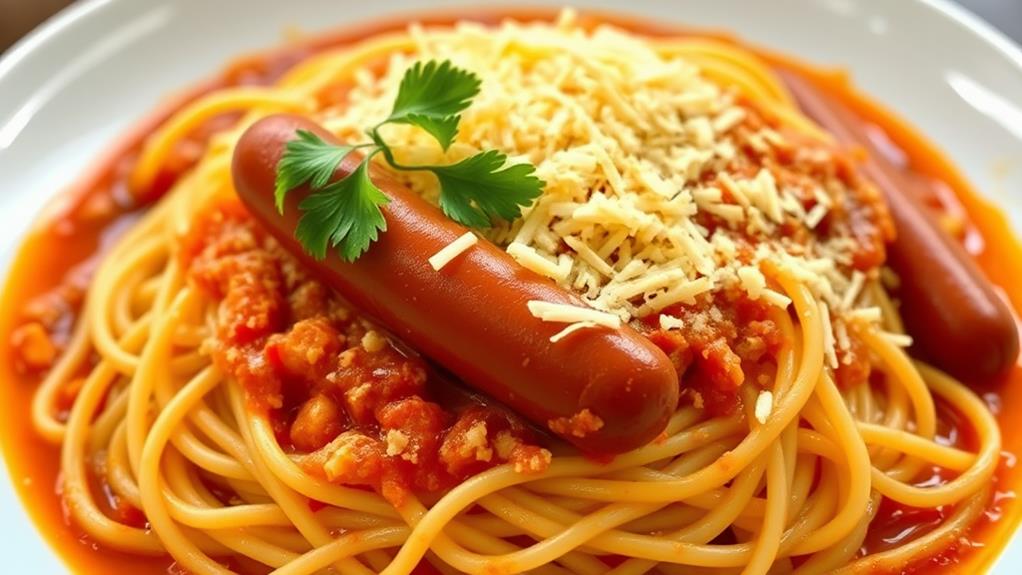
Filipino Spaghetti: A Sweet and Savory Twist
Filipino Spaghetti is a unique fusion of sweet and savory flavors, differing from its Italian counterpart.
This dish combines ground pork, sweet tomato sauce, and unexpected ingredients to create a harmonious blend of flavors.
Key Ingredients and Cooking Techniques
To make Filipino Spaghetti, add sliced hotdogs and ground pork to your pot to create a savory depth in your sweet tomato sauce.
Use banana ketchup and brown sugar liberally, as they're the secret ingredients that give Filipino Spaghetti its signature flavor.
Simmer the sauce for at least 30 minutes to allow the flavors to meld together and the aroma to fill your kitchen.
Assembling the Dish
Combine al dente noodles with the rich, thick sauce to create a satisfying and filling meal.
Top with shredded quick melt cheese to add a creamy and indulgent touch. This dish is perfect for children's birthday parties and other celebrations.
Perfecting the Sweet Sauce
Achieving the Perfect Balance of Sweet and Savory
To create the signature sweet sauce of Filipino Spaghetti, it's essential to strike a balance between sweet and savory flavors. Incorporate banana ketchup and a touch of brown sugar to counteract the acidity of the tomatoes. This combination will provide a solid foundation for the sauce.
Adding Richness and Depth
Introduce ground pork, sliced hotdogs, and liver spread to enrich the sauce with meaty flavors and textures. These ingredients will add depth and complexity to the overall taste.
Simmering for Flavor Melding
Simmer the sauce for at least 30 minutes to allow the flavors to meld together and thicken into a sticky, saucy consistency. This step is crucial in developing the sauce's character.
Elevating the Umami Profile
Add a Knorr Pork Cube or Magic Sarap to enhance the umami flavor profile of the sauce. This addition will make a noticeable difference in the overall taste.
Cooking Tips and Variations
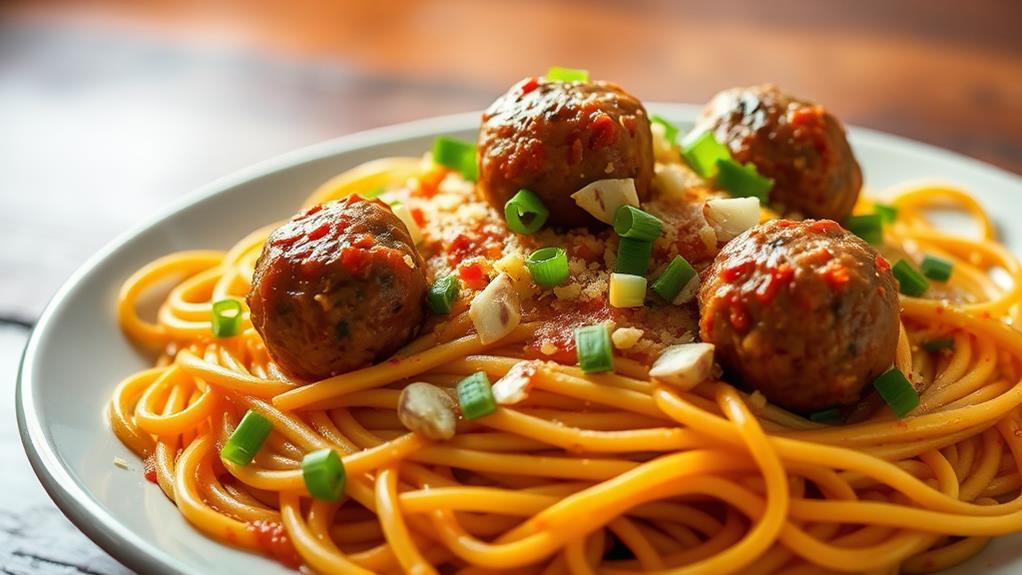
Elevate Your Filipino Spaghetti with These Essential Cooking Tips and Variations
Protein Powerhouse: Add sliced hotdogs and ground pork to create a meaty twist.
For added flavor, incorporate Spam or bacon.
Rich and Depth-Filled Sauce: Simmer the sauce with a Knorr Pork Cube to achieve a rich flavor.
Consider adding a spoonful of liver spread for a unique taste.
Balancing the Sauce: Combine banana ketchup with a splash of regular tomato sauce and a pinch of sugar to achieve a balanced sweetness.
The Perfect Plate: Top your spaghetti with shredded Velveeta cheese for a creamy finish that complements the sweet sauce.
Sauce Thickness Control: Adjust the sauce's thickness by incorporating reserved pasta water during mixing.
This ensures the sauce clings to the noodles without being too dry or watery.
Nutrition Information and Facts
Nutrition Information for Pinoy-Style Spaghetti
A serving of Pinoy-style spaghetti contains approximately 529 calories. The macronutrient breakdown is 63g carbohydrates, 23g protein, and 19g fat.
Sodium Content: A serving of this dish contains 1068mg of sodium, which is a significant amount. It's essential to be mindful of salt intake to maintain good health.
Vitamin A Content: Pinoy-style spaghetti is a rich source of Vitamin A, providing around 1190 IU per serving. This is beneficial for eye health and immune function.
Fiber Content: This dish contains 4g of fiber per serving, which aids in digestion and promotes a feeling of fullness.
Sugar Content: The sweetness in Pinoy-style spaghetti comes from added ingredients like banana ketchup and tomato sauce, contributing to 14g of sugar per serving.
Serving Suggestions and Ideas
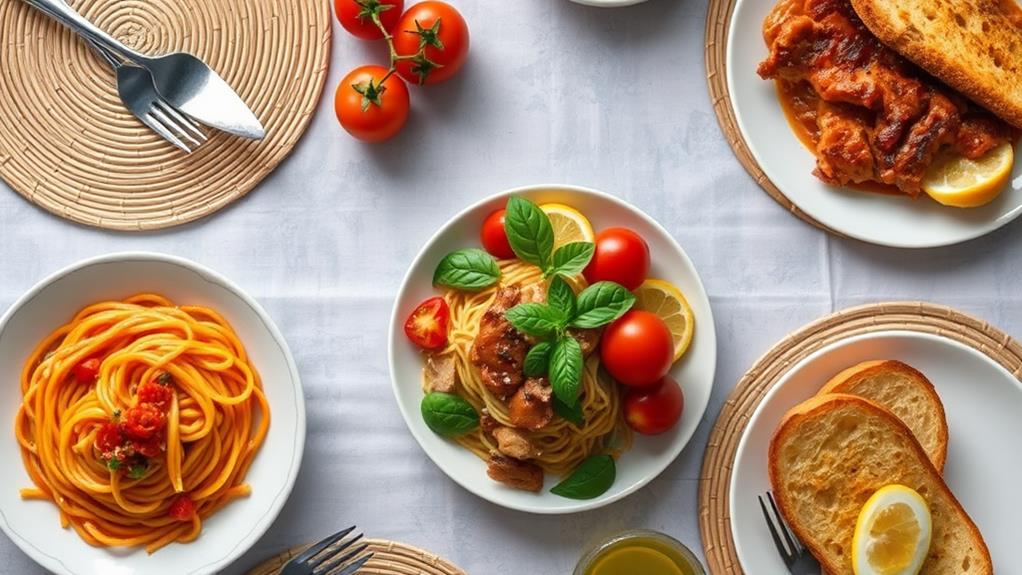
Pairing Pinoy-Style Spaghetti with Other Dishes
Pairing Pinoy-style spaghetti with other dishes can elevate the meal from satisfying to sublime.
Pairing it with Butter Garlic Whole Fried Chicken adds savory flavors that beautifully complement the sweetness of the spaghetti.
Alternatively, serving it with Calamares (crunchy fried squid) adds a delightful crunch and a seafood twist.
For a lighter option, an Easy Chicken Caesar Salad provides a refreshing contrast to the sweet and hearty flavors of the spaghetti.
Casual Setting Options
For a more casual setting, serve your Filipino spaghetti recipe alongside garlic bread to soak up the rich Filipino Style spaghetti sauce.
Additionally, offering a side of mixed vegetables balances the meal and provides a nutritious element that pairs well with the spaghetti's flavors.
Storing Leftovers the Right Way
Storing Leftovers the Right Way
Separate Containers for Freshness
To maintain the quality of your leftovers, store your meat sauce and noodles in separate airtight containers. This prevents the noodles from becoming soggy and mushy, keeping them fresh for a longer period.
Refrigeration and Freezing Guidelines
When storing leftovers, refrigerate them within two hours of cooking to keep them fresh for up to 3 days. If you're not planning to consume them within that timeframe, consider freezing them.
Place the spaghetti and sauce in airtight containers or heavy-duty freezer bags, and they'll be good to go for up to 2 months.
Reheating and Safety Precautions
To reheat your frozen spaghetti, simply submerge it in boiling water or heat the sauce separately and mix it with the noodles.
Always check for signs of spoilage, such as discoloration or strange odors, and discard any spaghetti that appears off.
Cultural Significance and Origins
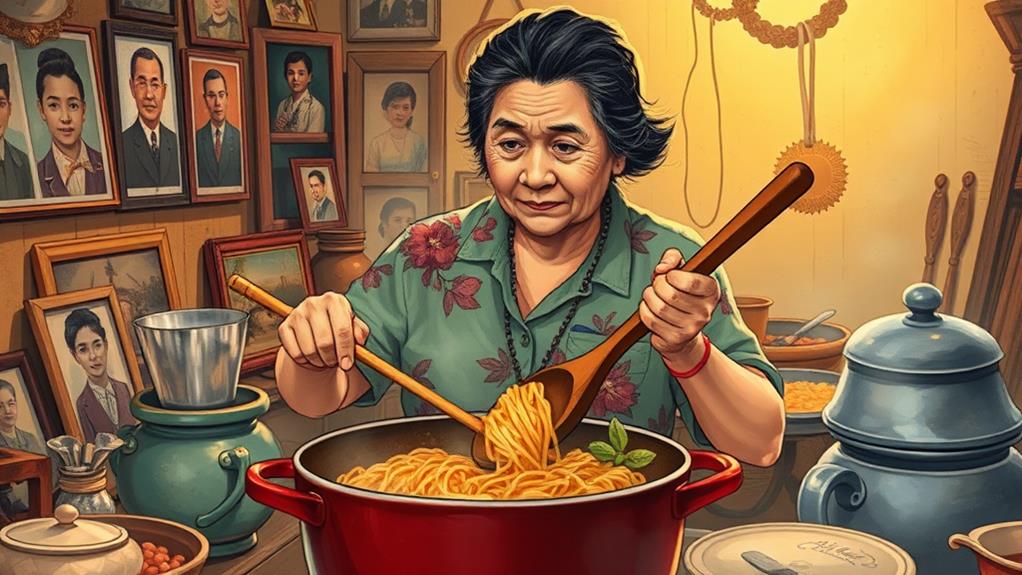
Filipino spaghetti holds a special place in the hearts of many Filipinos, evoking memories of childhood birthday parties and family gatherings.
The dish's unique flavor profile, characterized by a sweet and tangy sauce, is a far cry from traditional Italian tomato sauce.
This distinct flavor is a result of American colonization, which introduced ingredients like hot dogs and ketchup to the local cuisine.
The origins of Filipino spaghetti can be traced back to an orphanage in Cebu, where it was adapted to include local flavors.
One key ingredient in this adaptation was banana ketchup, developed by Maria Orosa.
This adaptation has since evolved into a comfort food that evokes nostalgia, reflecting the cultural significance of food in fostering familial connections and celebrations within the community.
Key Ingredients and Flavor Profile
Key Ingredients:
Filipino spaghetti's unique flavor profile relies on a distinct blend of ingredients. Banana ketchup is a primary component, adding sweetness and a tangy twist to the traditional Italian sauce.
Ground pork serves as the common meat base, often augmented with sliced hotdogs that contribute flavor and a chewy texture. Additionally, liver spread is typically included, enriching the sauce with depth and richness.
Flavor Profile:
The sauce's acidity is balanced by a hint of brown sugar, which amplifies the overall sweetness characteristic of this comfort food.
Quick-melting cheese, such as cheddar or Velveeta, is frequently used as a topping, providing a creamy texture that complements the sauce's sweetness.
These key ingredients combine to create a dish that's both familiar and unique.
Cooking Techniques and Essentials
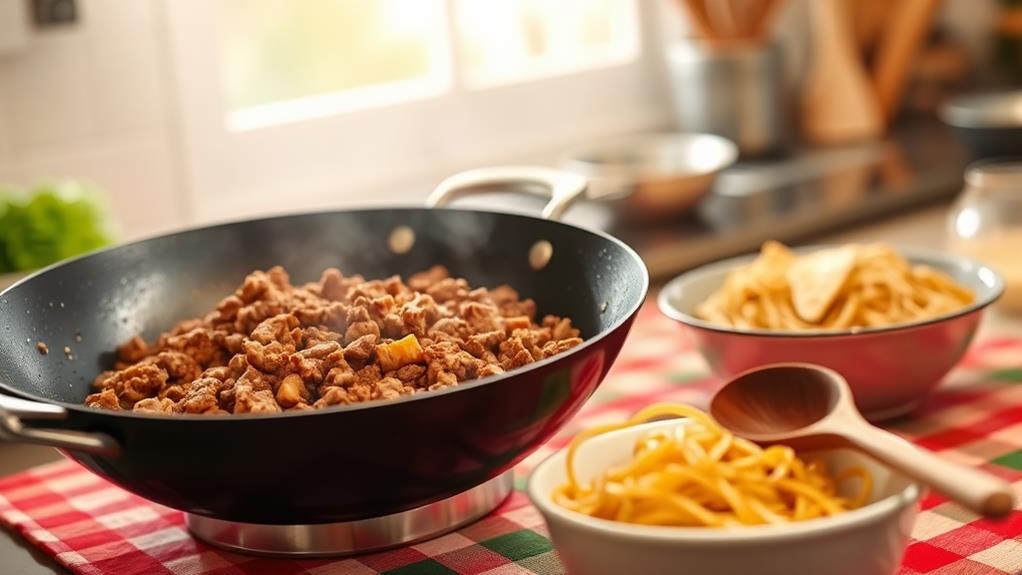
Mastering Filipino Spaghetti: Cooking Techniques and Essentials
To create a flavorful Filipino spaghetti dish, it's essential to master specific cooking techniques. Layering flavors is key, and this begins with cooking the spaghetti noodles.
Cooking Spaghetti Noodles
Cook spaghetti noodles according to package instructions, ensuring they're al dente for the best texture when mixed with the sauce.
Sautéing Aromatics and Meat
Sauté minced onion and garlic in oil until softened, then add ground pork and hotdogs. Allow the flavors to meld and the meat to brown properly, which takes time.
Developing the Sauce
Add banana ketchup and liver spread, signature ingredients in Filipino spaghetti, to the sautéed mixture.
Simmer the sauce with added water and seasoning until it thickens, creating a cohesive dish when combined with the noodles.
Assembling the Dish
Mix the cooked spaghetti with the sauce thoroughly, then top with shredded cheese for an added layer of flavor and creaminess.
What’s the Secret Ingredient for Perfecting Spaghetti Pinoy Style?
The essential ingredients for spaghetti pinoy include banana ketchup, hotdogs, and ground pork. These give the dish its distinct sweet and savory flavor. To perfect your spaghetti pinoy style, make sure to master the balance of these key ingredients for an authentic Filipino spaghetti experience.
Reader Engagement and Community
Share Your Filipino Spaghetti Creations
Tag @PanlasangPinoy on Instagram to showcase your Filipino spaghetti creations and get inspired by others who share your passion.
Take Your Reader Engagement to the Next Level
To engage with the community, remember these three essentials:
Interact with Others: Leave a comment, ask a question to share your thoughts, ask for tips, or say hello. This is where you can learn from others and build connections.
Provide Feedback: Rate those recipes you try, as your feedback helps others make informed decisions and creates a sense of community.
Explore and Discuss: Explore related posts featuring various Filipino recipes and participate in discussions about personal experiences and variations of Filipino spaghetti.
This is where cultural exchange happens, and you'll gain a deeper appreciation for this beloved dish.
Frequently Asked Questions
What Makes Filipino Spaghetti Different?
Filipino spaghetti stands out due to its sweet sauce. This unique flavor profile comes from the combination of banana ketchup and brown sugar.
Cultural influences have shaped this dish. It blends traditional and modern flavors, resulting in a distinct taste experience.
The ingredients add texture and flavor. Ground pork, hotdogs, and luncheon meat contribute to the savory goodness, while melted cheese provides a rich finish.
Filipino spaghetti is a staple at celebrations. Its vibrant red color makes it a popular choice for birthday parties and family gatherings.
How Can I Make My Spaghetti More Flavorful?
To make flavorful spaghetti, use a combination of herbs and spices. Add fresh or dried herbs like basil, oregano, or thyme to give your sauce depth. You can also add spices like red pepper flakes for a spicy kick or fennel seeds for a mild anise flavor.
Master the balance of sweet, savory, and umami flavors in your sauce. Sweetness comes from caramelized onions or a pinch of sugar, while savory flavors come from ingredients like garlic, mushrooms, or olives. Umami flavors are found in ingredients like tomatoes, soy sauce, or miso paste. Balance these flavors to create a rich and complex sauce.
Perfect your cooking technique to lock in flavors. Sautéing vegetables and meat in a hot pan with a small amount of oil helps to caramelize their natural sugars and enhance their flavors.
This step is crucial in creating a flavorful spaghetti dish.
What Is the Secret to Good Spaghetti?
To achieve perfect spaghetti, three essential factors must be considered: texture, sauce balance, and ingredient quality.
Texture is crucial: Spaghetti must be cooked al dente, retaining a firm bite. This texture allows the noodles to hold the sauce without becoming mushy.
Overcooking can lead to an unappealing, soft mess.
Sauce balance is vital: A good spaghetti sauce should be neither too sweet nor too acidic.
The ideal balance is achieved by using a combination of ingredients, such as onions, garlic, and tomatoes, in harmony. This balance ensures the sauce complements the noodles without overpowering them.
High-quality ingredients are a must: Using fresh, high-quality ingredients, such as fresh tomatoes and real cheese, makes a significant difference in the overall flavor and texture of the dish.
Avoid using low-quality alternatives, as they can compromise the authenticity of the spaghetti.
Why Do Filipinos Put Ketchup in Spaghetti?
Filipinos add ketchup to spaghetti due to the cultural influence of American colonization.
During the American colonial period, the Philippines adopted many Western customs, including food preferences. This led to the incorporation of ketchup into traditional Filipino dishes, such as spaghetti.
The practice continued during World War II, when banana ketchup was invented as a substitute for tomato ketchup, which was scarce at the time.
The sweet and tangy flavor of ketchup complements the savory taste of spaghetti, making it a staple in Filipino cuisine.
This unique twist on traditional spaghetti has become an integral part of Filipino gatherings and celebrations.
The addition of ketchup adds a burst of flavor and fun to the dish, making it a beloved cultural tradition.
